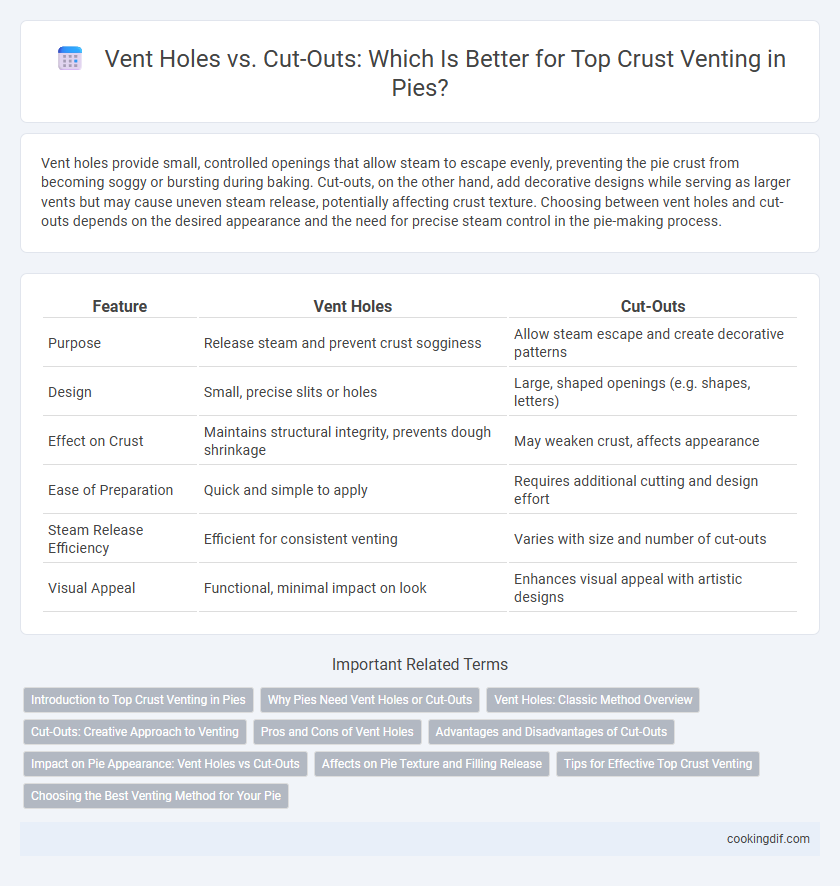Vent holes provide small, controlled openings that allow steam to escape evenly, preventing the pie crust from becoming soggy or bursting during baking. Cut-outs, on the other hand, add decorative designs while serving as larger vents but may cause uneven steam release, potentially affecting crust texture. Choosing between vent holes and cut-outs depends on the desired appearance and the need for precise steam control in the pie-making process.
Table of Comparison
| Feature | Vent Holes | Cut-Outs |
|---|---|---|
| Purpose | Release steam and prevent crust sogginess | Allow steam escape and create decorative patterns |
| Design | Small, precise slits or holes | Large, shaped openings (e.g. shapes, letters) |
| Effect on Crust | Maintains structural integrity, prevents dough shrinkage | May weaken crust, affects appearance |
| Ease of Preparation | Quick and simple to apply | Requires additional cutting and design effort |
| Steam Release Efficiency | Efficient for consistent venting | Varies with size and number of cut-outs |
| Visual Appeal | Functional, minimal impact on look | Enhances visual appeal with artistic designs |
Introduction to Top Crust Venting in Pies
Top crust venting in pies is essential for releasing steam during baking to prevent soggy fillings and ensure even cooking. Vent holes are small perforations made with a fork or knife, allowing controlled steam escape while maintaining crust integrity. Cut-outs involve decorative shapes cut from the dough, serving as functional vents that also enhance the pie's visual appeal.
Why Pies Need Vent Holes or Cut-Outs
Pies require vent holes or cut-outs in the top crust to allow steam to escape during baking, preventing the filling from becoming overly watery and ensuring the crust remains crisp. Without proper venting, pressure builds up inside the pie, which can cause the crust to crack or bubble unevenly, compromising the texture and appearance. Effective venting optimizes heat distribution and moisture control, resulting in a perfectly cooked pie with a golden, flaky crust.
Vent Holes: Classic Method Overview
Vent holes in pie crusts serve as traditional steam vents that prevent soggy fillings by allowing moisture to escape during baking. This classic method involves puncturing small holes or slits evenly across the top crust, ensuring even heat distribution and reducing the risk of crust bubbles. Proper vent hole placement enhances the pie's texture and maintains a crisp, golden finish without compromising the aesthetic appeal.
Cut-Outs: Creative Approach to Venting
Cut-outs offer a creative approach to pie top crust venting by allowing intricate shapes and patterns that enhance both appearance and function. This method provides precise control over steam release, preventing soggy crusts and preserving the pie's texture. Using cut-outs also enables bakers to personalize pies, adding visual appeal while maintaining effective ventilation.
Pros and Cons of Vent Holes
Vent holes in a pie's top crust allow steam to escape evenly, preventing soggy filling and maintaining crust crispness. Their simplicity and uniformity reduce the risk of filling spills compared to larger cut-outs but may limit decorative options. However, vent holes can sometimes cause uneven browning around the perforations and offer less dramatic visual appeal.
Advantages and Disadvantages of Cut-Outs
Cut-outs for top crust venting in pies allow larger steam release, preventing soggy crusts and burnt fillings by promoting better airflow. They offer decorative customization options but risk filling leakage and uneven baking due to larger openings. While cut-outs enhance visual appeal and moisture control, they require careful design to balance ventilation and structural integrity.
Impact on Pie Appearance: Vent Holes vs Cut-Outs
Vent holes create a subtle and uniform pattern on the pie crust, preserving a classic and polished appearance that emphasizes the pie's golden, flaky texture. Cut-outs provide a decorative, eye-catching design that can showcase creative shapes, enhancing the pie's visual appeal and making it a centerpiece. Choosing between vent holes and cut-outs significantly influences the pie's aesthetic, balancing subtlety and artistry in presentation.
Affects on Pie Texture and Filling Release
Vent holes in the top crust of a pie allow steam to escape evenly, preventing sogginess by maintaining a crisp crust and ensuring the filling thickens uniformly. Cut-outs, often decorative shapes, not only provide ventilation but also create larger openings, which can lead to faster moisture release, sometimes causing the filling to dry out or reduce in volume. Choosing between vent holes and cut-outs impacts the pie's texture by controlling steam escape rates, directly affecting crust flakiness and filling consistency.
Tips for Effective Top Crust Venting
Vent holes and cut-outs both serve to release steam and prevent the pie crust from becoming soggy, ensuring a crisp, golden finish. Use small, evenly spaced vent holes for controlled steam release and minimal filling loss, or decorative cut-outs for enhanced aesthetics while allowing ample ventilation. For optimal venting, score the top crust with multiple slits or shapes to balance steam escape and maintain structural integrity during baking.
Choosing the Best Venting Method for Your Pie
Vent holes provide controlled steam release and help prevent soggy crusts by allowing moisture to escape evenly during baking. Cut-outs, often decorative shapes, offer larger openings that enhance venting but may lead to faster moisture loss and less crust support. Selecting the best venting method depends on pie type, baking time, and desired crust texture, with vent holes ideal for fruit pies and cut-outs suitable for heavier fillings needing extra steam release.
Vent holes vs Cut-outs for top crust venting Infographic

 cookingdif.com
cookingdif.com